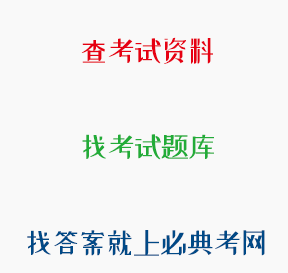正确答案: D
李时珍--《天工开物》
题目:下列选项中,作家与作品对应不正确的一项是( )。
解析:《天工开物》是宋应星的作品,李时珍的作品是《本草纲目》。故选择D。
查看原题 查看所有试题
学习资料的答案和解析:
[单选题]段落标记中,保存着( )。
段落标记所在段落的格式信息
解析:段落标记是对本段格式信息的标记--所在段落的格式信息,故选择C。
[单选题]"建国君民,教学为先"体现了哪两者之间的关系?( )
教育与政治
解析:"建国君民,教学为先"体现了教育与政治之间的关系。
[多选题]学校教育制度在形式上的发展经历的过程有( )。
前制度化教育
制度化教育
非制度化教育
解析:历史上的教育经历了从非正式教育到正式教育、从非正规教育再到正规教育的演变。以制度化教育为参照,之前出现的非正式、非正规教育都可归为前制度化教育,而之后出现的正式、正规化教育则都归为非制度化教育。因此,教育制度的发展经历了从前制度化教育到制度化教育,再到非制度化教育的过程。
[单选题]保持在人脑中的过去的体验或信息,平时虽然不被觉知,但可由需要时复现或提取而达到觉知的意识状态是( )。
前意识水平
解析:前意识水平是指保持在人脑中的过去经验或信息,平时虽然不被觉知,但可由需要时再复现或提取而达到觉知的意识状况。
[多选题]教师应怎样帮助学生提高知觉理解性?
[多选题]情绪与情感的反应特点不同,情绪具有( )。
情境性
激动性
暂时性
解析:情绪与情感的区别,从反应特点看,情绪具有情境性、激动性、暂时性、表浅性、外显性,情感具有稳定性、持久性、深刻性、内隐性。
[单选题]What is the main rhetoric device used in "The plowman homeward plods his weary way."?
Transferred epithet
解析:metaphor(隐喻/暗喻)是在两个不同事物之间进行比较,但它不直接点明两个事物之间的相似性,而是进行隐藏的比较,例如:All the world is a stage.整个世界是一台戏(用stage喻指all the world)。metonymy(转喻)指直接用比喻事物代替本体事物,例如:The buses in America are on strike now.美国的公共汽车司机正在罢工(这里buses喻指司机drivers)。synecdoche(提喻)指用一般代替特殊或以特殊代替般,部分代替整体或整体代替部分,或用原材料代表用该材料制造的东西。比如以hands代替persons,以Solomon代替a wise man,以the smiling year代替the spring transferred epithet(移就)指用本应该描述甲事物性质状态的词语来形容乙事物,而乙事物却根本不具备这种性质或功能。例如题干中的“The plowman homeward plods his weary way.”句中形容词“weary”本来应该修饰的是the plowman”,作者在这里用来修饰“way”,使这句话勾勒出一幅筋疲力尽的农夫步履蹒跚地走向家园的画面。故选择D。
[单选题]2001年我国颁布的《基础教育课程改革刚要(试行)》明确规定,我国基础教育课程实行( )。
国家、地方、学校三级管理
解析:2001年我国颁布的《基础教育课程改革刚要(试行)》明确规定,我国基础教育课程实行国家、地方、学校三级管理。故本题选C。
[单选题]请阅读Passage 2,完成1~5小题。
Passage 2
Several research teams have found that newborns prefer their mothers' voices over those of other people.Now a team of scientists has gone an intriguing step further: they have found that newborns cry in their native language."We have provided evidence that language begins with the very first cry melodies," says Kathleen Wermke of the University of Wurzburg,Germany,who led the research.
"The dramatic finding of this study is that not only are newborns capable of producing different cry melodies,but they prefer to produce those melody patterns that are typical for the ambient language they have heard during their fetal life,within the last trimester," said Wermke."Contrary to orthodox interpretations,these data support the importance of human infants' crying for seeding language development."
It had been thought that babies' cries are constrained by their breathing patterns and respiratory apparatus,in which case a crying baby would sound like a crying baby no matter what the culture is,since babies are anatomically identical."The prevailing opinion used to be that newborns could not actively influence their production of sound." says Wermke.This study refutes that claim: since babies cry in different languages,they must have some control (presumably unconscious) over what they sound like rather than being constrained by the acoustical properties of their lungs,throat,mouth,and larynx.If respiration alone dictated what a cry sounded like,all babies would cry with a falling-pitch pattern,since that's what happens as you run out of breath and air pressure on the throat's sound-making machinery decreases.French babies apparently didn't get that memo."German and French infants produce different types of cries,even though they share the same physiology," the scientists point out."The French newborns produce 'nonphysiological' rising patterns," showing that the sound of their cries is under their control.
Although phonemes—speech sounds such as "ki" or "sh"—don't cross the abdominal barrier and reach the fetus,so-called prosodic characteristics of speech do.These are the variations in pitch,rhythm,and intensity that characterize each language.Just as newboms remember and prefer actual songs that they heard in utero,it seems,so they remember and prefer both the sound of Mom's voice and the melodic signature of her language.
The idea of the study wasn't to make the sound of a screaming baby more interesting to listeners-good luck with that-but to explore how babies acquire speech.That acquisition,it is now clear,begins months before birth,probably in the third trimester.Newborns "not only have memorized the main intonation pattems of their respective surrounding language but are also able to reproduce these pattems in their own [sound] production," conclude the scientists.Newborns' "cries are already tuned toward their native language" ,giving them a head start on sounding French or German (or,presumably,English or American or Chinese or anything else: the scientists are collecting cries from more languages).This is likely part of the explanation for how babies develop spoken language quickly and seemingly without effort.Sure,we may come into the world wired for language (thank you,Noam Chomsky),but we also benefit from the environmental exposure that tells us which language.
Until this study,scientists thought that babies became capable of vocal imitation no earlier than 12 weeks of age.That's when infants listening to an adult speaker producing vowels can parrot the sound.But that's the beginning of true speech.It's sort of amazing that it took this long for scientists to realize that if they want to see what sounds babies can perceive,remember,and play back,they should look at the sound babies produce best.So let the little angel cry: she's practicing to acquire language.
Which of the following is closest in meaning to the underlined word "ambient" in Paragraph 2?
Surrounding.
解析:词汇题。根据画线词定位到第二段。该段描述了婴儿在子宫中听到的声音是来自周围的语言。另外文章倒数第二段中也提到了“Newboms‘not only have memorized…oftheir respective surrounding language…'"。所以“ambient”与“surrounding”的意思接近,本题选A。familiar“熟悉的”,foreign“外国的”,local“当地的”。

 川公网安备 51012202001360号
川公网安备 51012202001360号